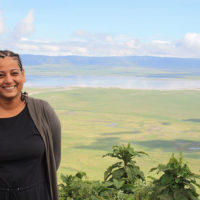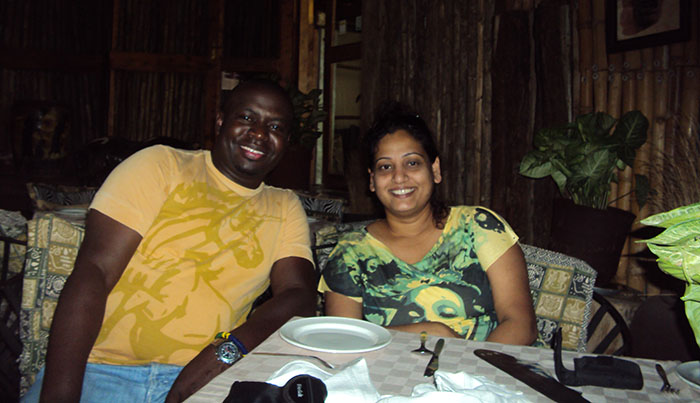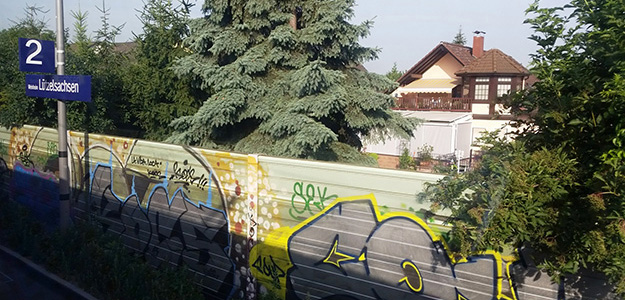Lake Manyara Park is very different to TNP. It is far denser and although smaller than TNP, it holds promises. The first animal to greet us here is the warthog, which refuses to move until I have him on camera.
“Manyara is cruel,” Reuben warns. “We will keep the roof down. Sometimes mamba snake can fall from trees.”
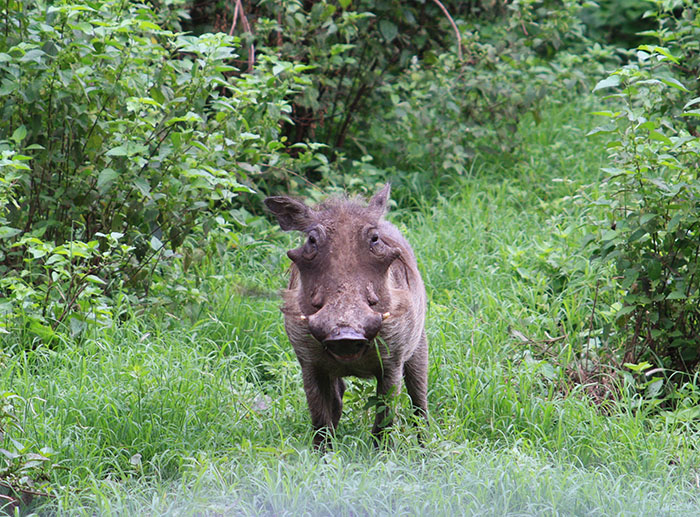
I feel uneasy. Somehow I have not realized that danger is around us. A shiver crawls up my spine at the mention of snakes. Reuben adjusts the roof as a precaution. Peering out of windows is going take some fun out of the game drive and reduce my chances of seeing a tree lion, but if I have to choose between a mamba crawling up a tree and up my spine, I’d choose the former. I place my faith in Reuben because I want to live to tell the tale. Lake Manyara is so different from Tarangire National Park that I have just come from.
I have a feeling that I was never meant to spot one anyway. I ask Reuben about this and he says in the wild patience is the key word.
“Tree-lions are very shy. They will not come if you call.” In other words, we will not be seeing any.
We drive to the Hippo pool to see a pod of beastly looking creatures rolling about making loud wheezing sounds and surfacing only infrequently. The area around the pool is flooded and I am forced to climb to the top of the car and try my luck at photographing them. My luck is out because hippos are clearly not in the mood for being photographed.
Lake Manyara National Park
Lake Manyara makes up most of the national park and is beautiful. Thousands of flamingoes stand on the water’s edge turning the lake into a sheet of pink. Nearby, in their distinctive black and white stripes zebras graze across the grass amongst the other herbivores in herds spread across several hundred meters. Buffalo, giraffe, deer and monkeys live peacefully in what looks like a sea of green pouring into the pink lake. Zebras nipped and bite each other as they run playfully. It is amazing to so much black and white bouncing over a rich green ground cover. Mongoose scurry about looking for food and bright coloured birds break into a cacophony. Any enthusiastic ornithologist would be keen to make Lake Manyara his home.
Hemingway called it the most beautiful lake in Africa. In these the spectacular flamingo-fringed soda lakes of Manyara Hemingway had hunted. Something catches my attention. It is a monkey with a blue scrotum.
“Vervet monkey,” says Reuben without interest.
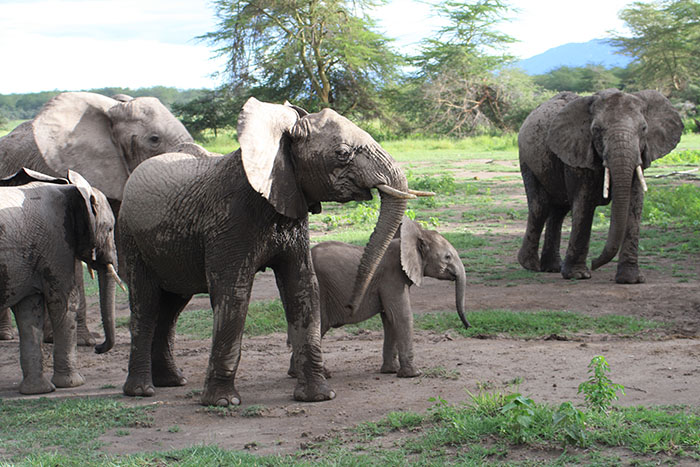
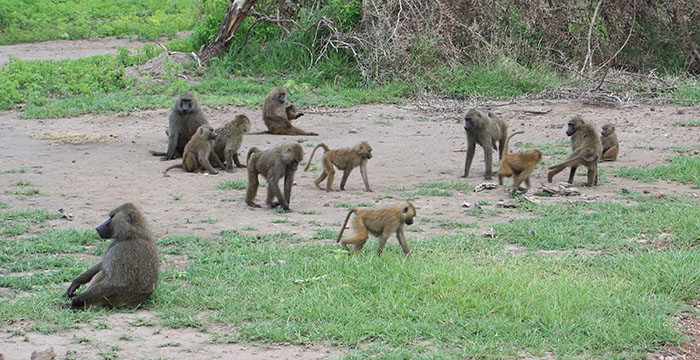
It is time to leave the Park. The lions of Manyara are nowhere to be seen. They could be a myth for all I know. We drive into Mosquito River town, a rather ruthless and rundown town perched close to Lake Manyara, trying hard to contradict its name. I am staying at Sun Bright Camp which is every bit like a campsite I have hoped to stay at. There is a small dining room and toilets with running water set to one side. It has been a long day of driving and a teaser to what is to come.
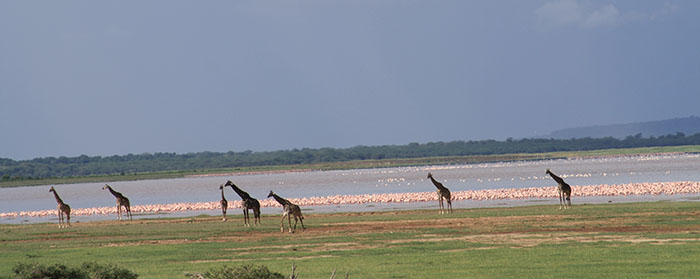
I wish of course to hear the roar of lions roar or the beats of the African drum to lull me to sleep, but contend with the sound of rain which is melodious enough and sleep comes despite the mosquitoes and uncomfortable bed.
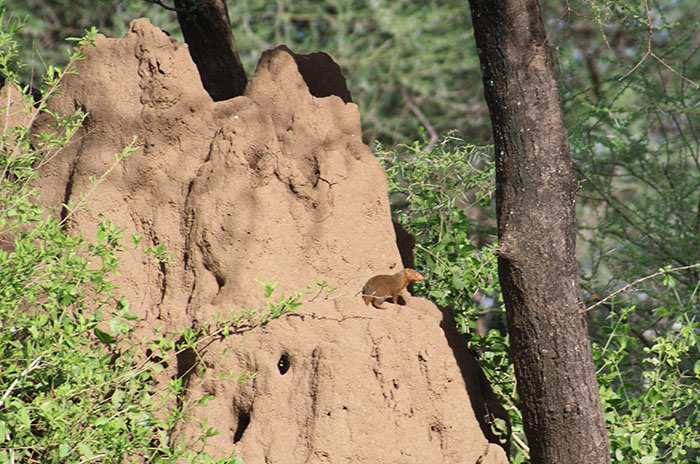
March 30, 2010
The morning is damp but it is wonderful to wake up in an obscure and unfamiliar town. The camp restaurant is not ready with coffee so I walk into town. It is still dark and wet. The road appears like a long snake. Leafless bushes by the side of the road have a ghost like appearance when the headlights of the car shine their light on them in passing. The town is still asleep.
There is no coffee to be had anywhere.
Hakuna matata.
I will wait for the camp to come to life. No problem at all. Today, I will share my car with a German named Mattew. Reuben explains to me that we will drive back to Lake Manyara National Park and on towards Ngorongoro Crater today and once we reach Serengeti tomorrow, Mattew will continue in another car.
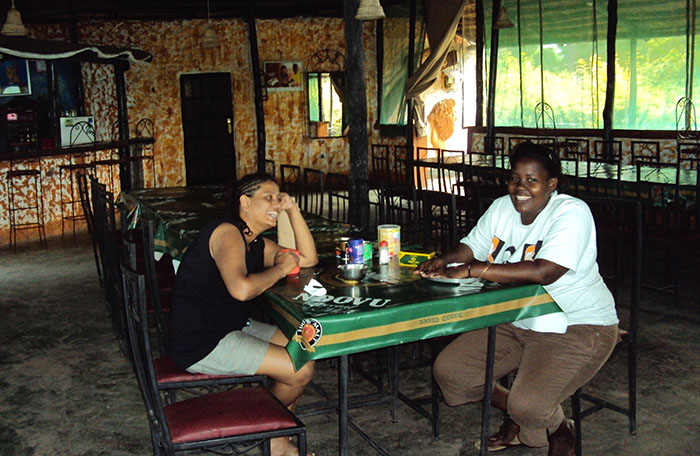
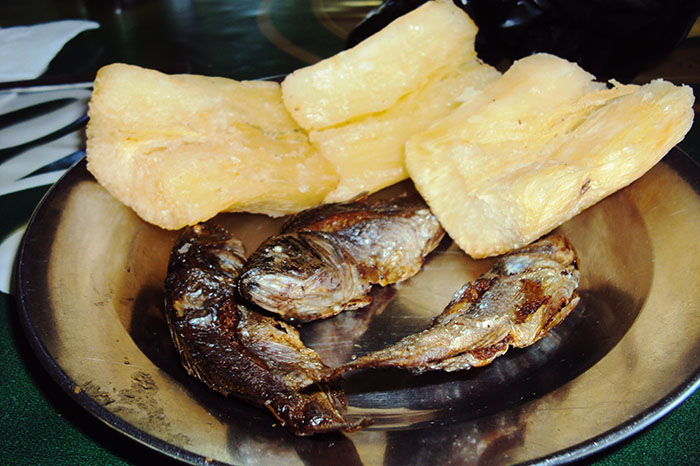
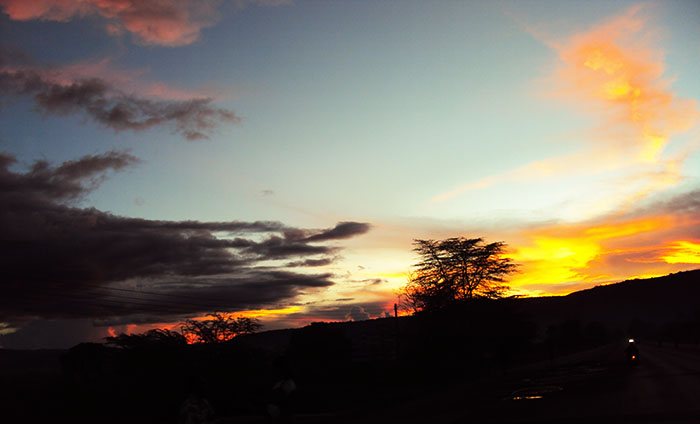
I don’t understand this set up but I am glad for his company.
It turns out that Mattew is not much of a conversationalist and prefers to bury himself in a book on African birds. I enjoy myself in silence, only occasionally speaking with Reuben.
Two hours of doing the rounds of Lake Manyara which is exactly what we did last evening, we finally leave the park and journey towards the Maasai village that is along the way to the Ngrorongo Crater our destination for the day. My earlier fascination for the Maasai people returns and the thought of seeing and perhaps touching them is making me jump in my seat.
“Reuben, do they speak English? What is the language they speak? Will they speak with us? Are they friendly? I saw one in Moshi and he seemed, you know, unfriendly.”
“In the village here, they are friendly. They can even speak English, some of them, not the women, but the men they talk to tourists always so they speak good English. But you be careful here. Leave the money in the car.”
“Do they steal? Pick pockets?
Reuben doesn’t reply directly. “You know, they are poor people. You must be careful. Maasais, they are clever with swords and sticks but also with money.”
The Maasai Village
The Maasai Village is a great set up, right in the middle of gentle green plains upon which hundreds of cattle graze. Despite wearing the touristy look it is a great set up because it manages to draw hundreds of tourists everyday which translates into touristic dollars. As we approach the village, a large number of Maasai men decked out in bright red kangas and necklaces greet us.
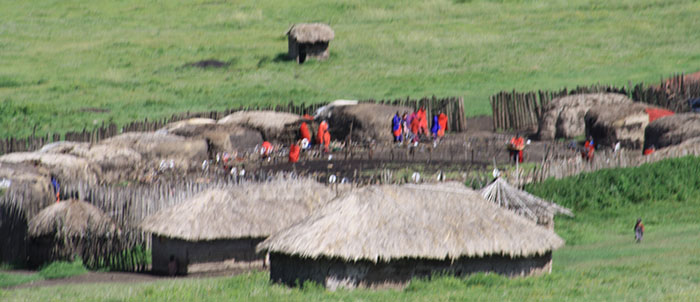
The men start deep rhythmic chanting and as we stand watching they launch themselves into air jumping under the sun of Africa. They dance and skip in a single file, throwing sticks and spears and oh ah ah-ing past us and then circling back again.
“Welcome to our village,” says the obvious leader of the pack. He is tall and wiry and has his eyes firmly fixed on me. He is smiling down at me now. I can smell him. He is a beautiful creature. Raw. I can see why Corinne Hoffman, the author of The White Maasai, married one of them. This handsome Maasai specimen exudes magnetism that is hard to resist. He doesn’t have an inch of flesh on him. His eyes bore into mine. His nostrils flare gently as he inhales the smell of a new arrival. Does he feel as hormonally charged as I do?
“Come, I show you the village. You see life of Maasai people here.”
Mattew has miraculously vanished.
I allow myself to be led by this handsome creature, following his long strides around the circular village. “Manyatta we call this,” he explains pointing at the small dung-plastered circular huts. It smells of dung. Little children in tattered clothes with saliva and snot on their faces come to stand by the entrance to their homes, looking shyly at us. Men are engaged in talking business.
“What language do you speak? Does everyone here speak English?”
“I learn from mzungu, but not all can speak English. Our language we call maa.”
“What’s your name?”
“Sabore.”
This village is altogether new and to someone who has never stepped out of a city, this could seems like world’s end – or better still, it will seem like something set up for a television show. But it is real. The tall, dark men and women in bright shawls and colourful beads watching is walk past are real. It is hard to comprehend that we share the same planet earth, but it is true.
In fact we even share a common trait with them – bargain. Yeah, the Maasais live deep inside Africa, but they surely know how to drive a bargain. They seem pretty good at it too – offering to exchange my Ray Ban for a bead necklace.
“You give sun glass, you take this,” says one with energy, pushing a gourd decorated with plastic beads in my direction. They clearly don’t know their math!
“Oh no, I am sure!” I reply equally forcefully. “I’ll keep my glasses, thank you.”
“You take two.”
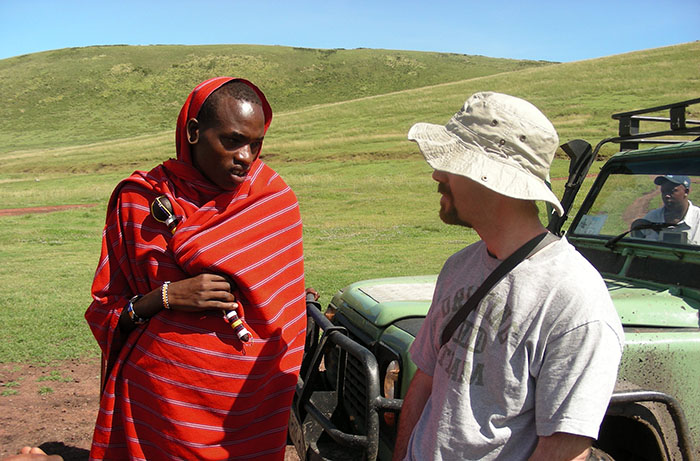
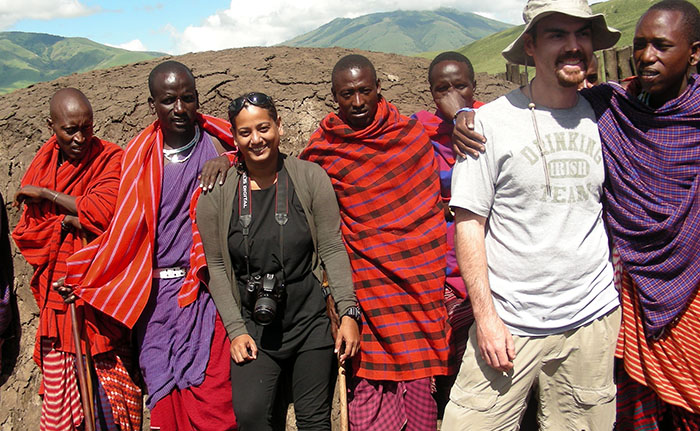
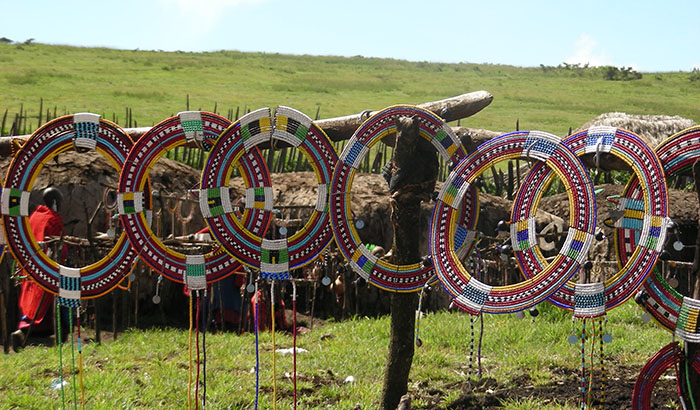
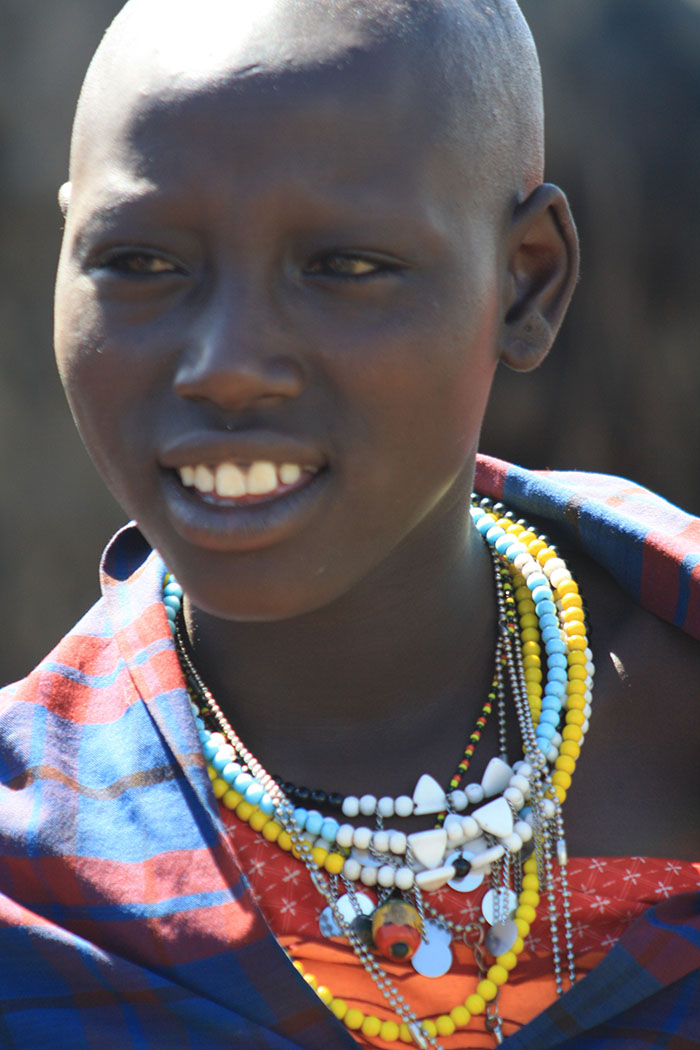
I was developing a sense of admiration for these people who have managed to strike a workable balance between living traditionally while taking on modern life with common sense, not giving up the opportunity that visitors can provide in terms of extra income. Sabore leaves me at the side of the village where women are busy making jewelry. “You will see the house now. You must go inside. Make photo no problem here.”
I am handed over to a tall and well-built woman whose neck is covered with beaded necklaces. Her ears have multiple holes and in each one of them there is a different ring made of beads. She has no hair. Her head is smooth and shiny.
She speaks very little English but offers a smile and invites me into her thatched hut made of Acacia branches with cows’ manure and grass as insulation. I enter one almost at a crawl, trying to avoid contact with the dung walls. Inside the dimly lit, low house, a woman lies on a bed and makes a gesture to indicate that I can sit with her. She tries to explain what life is like for the Maasai. I am very impressed with what they are able to build with just wood and other – certainly limited – resources from Mother Nature. The floors in their houses are the same dusty ground as outside. The hut itself contains only a small cooking spot and the sleeping areas, separate ones for the husband and the wife with the children.
Women it seems, do most of the exerting work in the village. They build huts and ensure there is food, firewood and water for the family. Sometimes they have to walk long distances to get these things. The young boys, who are not old enough to be a warrior, or moran in Kimaasai, herd the cattle. In the past boys became moran by killing a lion. This tradition has now disappeared like many other Maasai traditions have.
The warriors clearly don’t do much because they don’t have to go out of the village to take back cattle that was ‘theirs.’ Once upon a time cattle used to be the pivotal element of life in a manyatta and the Maasai thought all the cattle in the world was their property so they fought to take all the cattle they found on their way with them. Matters have changed now and many say that the warriors now lead an easy life. They are still the best-known tribes of Africa, being the best looking of them all. Actually – very good looking.
I meet Sabore again in the centre of the village. In a small circular enclosure there is a cow with a small plastic container hanging around its neck. Sabore launches into an explanation.
“Cow blood is good. It is our food. We boil the blood for special occasions like welcoming baby or marriage.”
“Is there a wedding soon? That is a lot of blood, what happens to the cow? Does it die?”
As I say this I try to avoid looking into the container that holds a quarter liter of dark blood. The poor cow burdened with flies and dripping blood tries unsuccessfully to flick its tail but manages a little wag before giving up and letting out a low moo. Somewhere behind a hut women break into peal of laughter and children scream. The idea of drinking cow blood is a little unorthodox but like the rest of the world, the Maasai too have their culture. I am intrigued and shaken up at the same time. I no more feel so attracted to Sabore.
“No. But sometimes we like change food. Some tourists like to try this Maasai food. Twenty dollars if you want it. You try?”
Sabore is smiling at me wickedly, very sure that I will not. I want to try, just to defy him but the cow lets out a low moon again and I want to run away.
“Are you married, Sabore?”
“Yes, I have two wives. Man can take many wives. Are you married?”
“No.”
“You are beautiful, you marry.”
Before we can go any further we hear the roar of cars. “Many tourists come now,” he says, now distracted by the prospect of inviting more tourists into his village. He is no more the teasing host urging me to try cow blood. He looks sharply at the entrance waiting for the tourists to walk in. I know he wants to leave. Tourists mean money and Sabore, like the rest of the Maasai people in the village is a man of business.
“Thank you for showing me around.”
“You are welcome,” he says to me and vanishes.
I see Mattew haggling over a bracelet he has no intention of buying. He winks at me as I edge closer. “These are pretty but with zero value. I cannot think of anyone who would like to have this.”
“You are right – nor do I. But, I am sure we will find something of value…you know, something different. Let’s keep looking.”
In the end I buy a pair of bead-studded ingri, a traditional Maasai gourd used to hold milk hoping that it does not remind me of the cow blood.
We say goodbye to the Maasai and leave and travel the last few kilometres to the crater.
We are passing through Ngrongoro Conservation Area (NCA). It is the end of black-topped roads and from here on it is dirt track all the way. Now I am beginning to experience the real thing. If we are lucky, Reuben tells us, we will find leopards sunning on the roads. The NCA is unique as it is the only conservation area that allows humans to co-habit with wildlife. Clearly, they perceive tourists as threats, but lions? Well, they are playmates.
On the way, we visit Olduvai Gorge, believed to be the cradle of humanity, a steep-sided ravine in the Great Rift Valley. Mattew in his rare moments of friendliness tells me that many remains of our ancestors are found here.
“Everything here is pretty neatly preserved in layers,” Mattew explains. His eyes are shining with knowledge and excitement. “Imagine all our ancestors are buried there. There are many evidences that mankind occupied this year almost two million years ago.”
I am impressed by this declaration and at the same time acutely aware of my limited knowledge of this country. So besides the mountains and handsome Maasai men, Tanzania is in the big league of paleontologists, geologists and archaeologists. How have I not picked up on that earlier?
I have questions to ask but I am not sure if Mattew will answer them and make a note of reading up about it when I return.
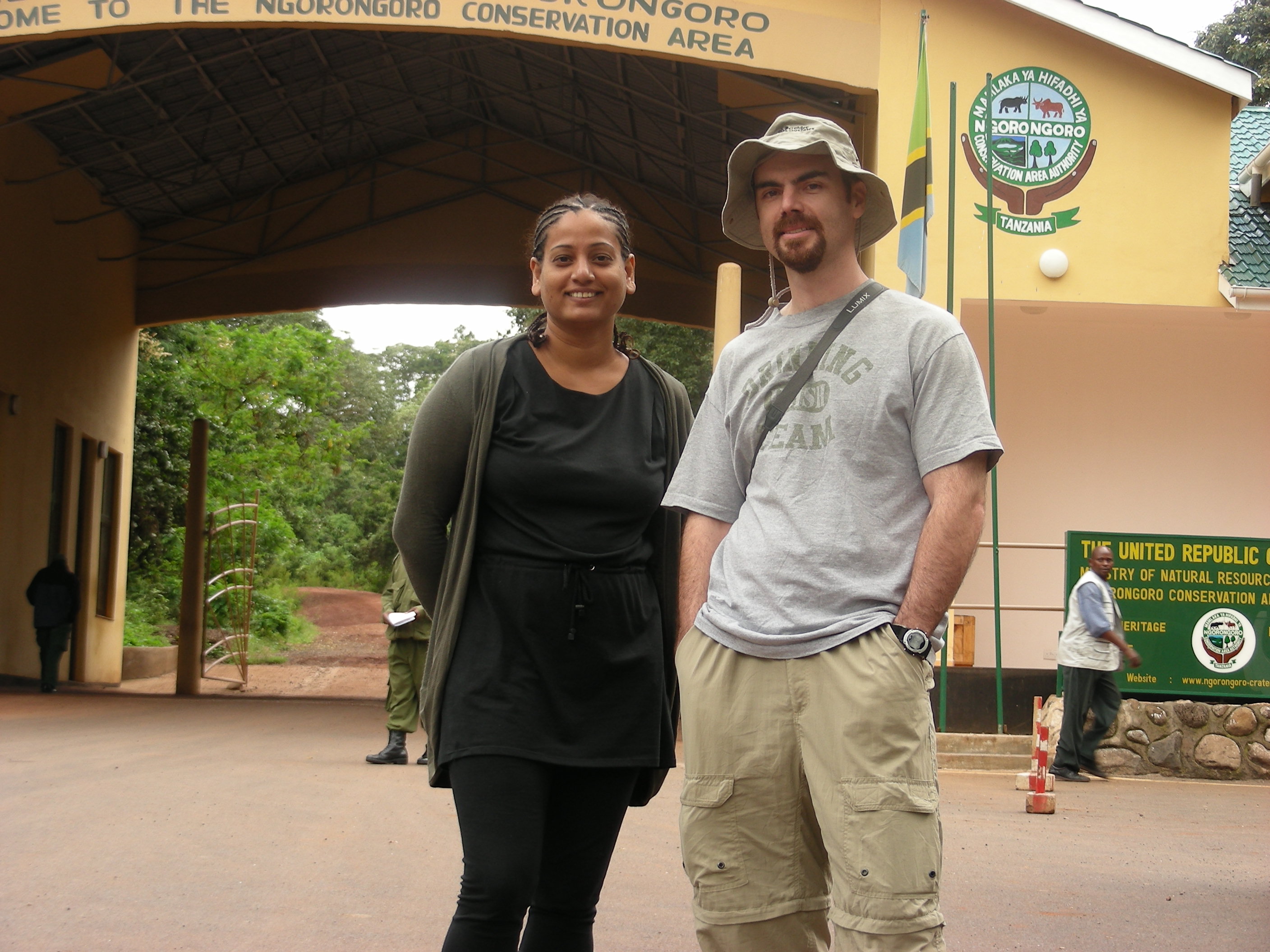
Mattew is very excited. At last I venture to ask him why he is on this trip and he looks at me coldly. Then his expression changes when the meaning on what I ask dawns and he says simply, “I am interested in history of mankind.”
I do not know what to say to that and I grunt out a “very nice” and turn to Reuben.
The road to Ngorongoro is the worst we have been on since we started. It’s bumpy because there are potholes and rocks everywhere. Also, the dust flies up like crazy. Not just because of us, there is also oncoming traffic and cars that overtake us. We’re all eating dust. Reuben says this is the part of the trip he hates; having to breathe dust, but there is not much he can do.
We arrive at the edge of Ngorongoro Crater covered in dust. I want a shower but which, upon inquiring, I realize is not forthcoming. I will have to wait until tomorrow. We have limited supply of water but fortunately I have a good supply of toilet paper, something I have found to be extremely handy for the use of bush toilet.
I spend the night in a flimsy tent pitched by the two men at the Crater edge. I am getting used to sleeping in tents on a very thin mattress but for the first time the real feel of being out in the open is sinking in. Reuben and Mattew are in nearby tents and other than that, we are cut off from civilization. No other camper has ventured out to this side of the gorge. My worst fear is that we have unknowingly set up the tent over a snake or something equally crawly but fortunately such fears only exist in the mind.
However, the thought of waking up with a lion is a pleasant one or even a leopard or a cheetah. Even a giraffe will do.



